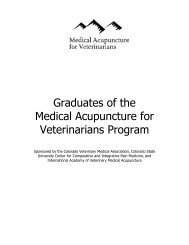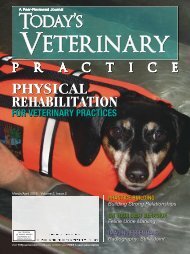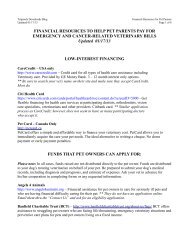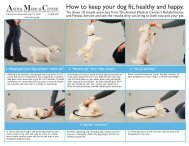Alternatives to Canine Surgeries - Tripawds Downloads
Alternatives to Canine Surgeries - Tripawds Downloads
Alternatives to Canine Surgeries - Tripawds Downloads
Create successful ePaper yourself
Turn your PDF publications into a flip-book with our unique Google optimized e-Paper software.
<strong>Alternatives</strong> <strong>to</strong> <strong>Canine</strong> <strong>Surgeries</strong> - Whole Dog Journal Articlehttp://www.whole-dog-journal.com/issues/13_2/features/<strong>Canine</strong>-Ligamen...3 of 6 3/6/2013 9:12 PMhelps prevent cartilage in the dog’s joint from wearing away. “I give injections twice a week for two weeks,” says Dr.Hershman, “then once a week for maintenance.”She also recommends Wholistic <strong>Canine</strong> Complete Joint Mobility, which is apowder containing organic vitamins, minerals, digestive enzymes, hydrolizedwhitefish, immune-support ingredients, and pharmaceutical-gradeglucosamine, chondroitin and MSM (methyl sulfonyl methane), all of whichsupport healing, speed tissue repair, or help alleviate pain and inflammation.Standard Process products for improved ligament health include Ligaplex, whichcontains organic raw bone, herbs, and minerals, and the veterinary product<strong>Canine</strong> Musculoskeletal Support, which contains anti-inflamma<strong>to</strong>ry herbs, Pernacanaliculus, and whole-food ingredients that enhance tissue regeneration andimprove joint health.It is important <strong>to</strong> keep injured dogs from gaining weight, which can easilyhappen when their exercise routine is interrupted. “Overweight dogs have aharder time recovering from a cruciate ligament injury,” says Straus, “and theyare more at risk for injuring the other knee. I would feed a high-protein,low-carbohydrate, reduced-fat diet. Fat is high in calories and so should beBoth of Faith Rubenstein’s Briards, Dakota and Aubrey,<strong>to</strong>re a cruciate ligament at different times – turning Faithin<strong>to</strong> something of an expert on dealing with the injury!limited, but <strong>to</strong>o little fat will leave the dog feeling hungry all the time. Protein helps with wound healing and also <strong>to</strong>create and preserve lean muscle, while carbs are more likely <strong>to</strong> be s<strong>to</strong>red as fat. For those who feed kibble, I would cutback on the amount fed and add fresh, high-protein foods such as eggs, meat, and dairy. For seriously overweightdogs, this is one situation where I might consider using the drug Slentrol <strong>to</strong> help speed weight loss.”Physical therapyFaith Rubenstein’s Dakota received physical therapy from Carol Wasmucky, PT, a licensed physical therapist for humansin Herndon, Virginia, who founded Pet Rehab Inc. and works full-time with animals by referral from veterinariansthroughout Northern Virginia.She began Dakota’s treatment by measuring his hind legs, one of which had atrophied and was smaller than the other.“Our goal,” says Rubenstein, “was <strong>to</strong> have both legs measure the same. Dakota and I worked with a holistic veterinarian,who put him on nutritional and herbal supplements, and we did acupuncture as well. I restricted his activity so he wasnot allowed <strong>to</strong> run off-leash for six months, and during that time he had regular physical therapy. Dakota wasn’t aswimming dog but he became one, for swimming was the perfect exercise for him. After six months, both hind legswere the same 17 inches in girth. He was in great shape, his drawer test results improved <strong>to</strong> nearly normal, and hedidn’t need surgery.”Dogs who are intermittently lame with a partial tear of the cruciate ligament are ideal physical therapy patients, saysWasmucky. In addition <strong>to</strong> providing weekly or twice-a-week ultrasound, laser, and electrical stimulation treatments,she puts patients on a home strengthening program with range-of-motion and stretching exercises. “Every program isdifferent depending on the dog’s condition,” she says. “The owners are involved every day; I show them what <strong>to</strong> do. It’sjust like working with human injuries; if you want the best results, you have <strong>to</strong> do your homework.”Wasmucky, who has worked with thousands of canine patients over the past 10 years, encourages anyone whose doghas a partial tear <strong>to</strong> use physical therapy <strong>to</strong> build muscle so that even if surgery has <strong>to</strong> be performed, the dog goes inand comes out in better shape. “This means shorter rehab time,” she says, “and a faster recovery.”Swimming is such effective exercise for injured dogs that many veterinary clinics have installed swimming pools. “Dogswho can’t yet do weight-bearing exercises can start in a pool,” she says, “and as they get stronger, they’re able <strong>to</strong>progress through the exercise program. I check their progress in weekly appointments and make adjustments asneeded. It takes time <strong>to</strong> heal from ligament injuries and I like <strong>to</strong> be sure that dogs are completely well before theyresume agility or other demanding sports.”She requires a major commitment from owners. “It’s usually an hour or so every day in twice-a-day sessions,” she says,“and this can go on for months. It’s a big investment of time and energy, and it requires a motivated dog as well as amotivated owner, but it can make a world of difference in mobility and overall health.” For more about caninerehabilitation, see “<strong>Canine</strong> Rehab? Go, Go, Go” (Whole Dog Journal September 2009).Prolotherapy






